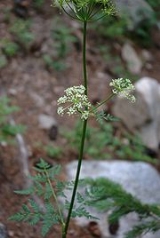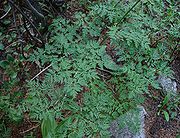
Osha
Encyclopedia
- For the U.S. government agency, see Occupational Safety and Health AdministrationOccupational Safety and Health AdministrationThe United States Occupational Safety and Health Administration is an agency of the United States Department of Labor. It was created by Congress of the United States under the Occupational Safety and Health Act, signed by President Richard M. Nixon, on December 29, 1970...
.
Osha or oshá (Ligusticum porteri) is a perennial herb. Osha grows in parts of the Rocky Mountains
Rocky Mountains
The Rocky Mountains are a major mountain range in western North America. The Rocky Mountains stretch more than from the northernmost part of British Columbia, in western Canada, to New Mexico, in the southwestern United States...
and northern Mexico
Mexico
The United Mexican States , commonly known as Mexico , is a federal constitutional republic in North America. It is bordered on the north by the United States; on the south and west by the Pacific Ocean; on the southeast by Guatemala, Belize, and the Caribbean Sea; and on the east by the Gulf of...
, especially in the southwestern United States
Southwestern United States
The Southwestern United States is a region defined in different ways by different sources. Broad definitions include nearly a quarter of the United States, including Arizona, California, Colorado, Nevada, New Mexico, Oklahoma, Texas and Utah...
.
Common names
Osha root, Porter's lovage, Porter's licorice-root, lovage, wild lovage, Porter's wild lovage, loveroot, Porter's ligusticum, bear medicine, bear root, Colorado cough root, Indian root, Indian parsley, wild parsley, mountain ginseng, mountain carrot, nipo, empress of the dark forest, chuchupate, chuchupati, chuchupaste, chuchupatle, guariaca, hierba del cochino or yerba de cochino, raíz del cochino, washí (tarahumara).In the Jicarilla language
Jicarilla language
Jicarilla is an Eastern Southern Athabaskan language spoken by the Jicarilla Apache.-Consonants:Jicarilla has 34 consonants:* What has developed into in Jicarilla corresponds to and in other Southern Athabaskan languages Jicarilla is an Eastern Southern Athabaskan language spoken by the...
, osha is called ha’ich’idéé. The White Mountain Apache call it '"Ha 'il chii' gah".
Distribution
Osha is strictly a mountain plant, and it is most commonly found in deep, moist soils rich in organic material. The plant requires partial shade. Osha is widely distributed from British Columbia south into Oregon and Washington State, and throughout the Rocky Mountains and the high mountains of New Mexico. It is most common in the upper limits of the subalpine zone, so in the southern part of its range, it grows at elevations from 7,000 feet to 10,000 feet (2100 m to 3000 m), while from Utah, Wyoming, and Montana northwards, it grows as low as 5,000 feet (1500 m).Osha is dependent on mycorrhiza
Mycorrhiza
A mycorrhiza is a symbiotic association between a fungus and the roots of a vascular plant....
l fungi, and attempts to artificially cultivate the plant outside of its habitat have not been successful. Cultivation of osha in areas where it naturally grows have been more successful.
Identification

Parsley
Parsley is a species of Petroselinum in the family Apiaceae, native to the central Mediterranean region , naturalized elsewhere in Europe, and widely cultivated as an herb, a spice and a vegetable.- Description :Garden parsley is a bright green hairless biennial herbaceous plant in temperate...
family, with parsley-like leaves and umbels of white flowers. The bases of the leaves where they attach to the root crowns have a reddish tint which is unique, and the roots are fibrous, with a dark, chocolate-brown, wrinkled outer skin. When this skin is removed, the inner root tissue is fibrous and yellowish-white with an overpowering, pleasant "spicy celery" fragrance that resembles lovage (Levisticum officinale).
Osha roots have a collar of dead leaf material surrounding the root crowns which is hairlike in appearance. The roots dry very quickly and are very astringent when fresh, and can cause blistering of the mouth and mucous membranes in humans if ingested fresh. The dried roots do not have this astringent affect. Roots of older plants are far stronger and bitter than those of younger plants.
Osha plants form large clumps over time, and can grow to be very large. In areas of New Mexico, Colorado, and Utah, osha can reach heights of 6 to 7 feet and produce circular colonies with dozens of root crowns growing from a central root mass. Osha is best harvested in the afternoon as the plants are relished by bears, which are known to visit the plants during the morning.
Similar species
Osha grows in the same habitat in areas of the Mountain West of North America with poison hemlock and water hemlock, highly poisonous members of the same family. Osha particularly resembles poison hemlock but is easily distinguished from it by its "spicy celery" odor, hair-like material on osha root crowns, and dark chocolate-brown, wrinkled root skin. Hemlock roots are white and fleshy and thin-skinned; they are typically heavily branched rather than carrot-like, but this is not always the case. Poison hemlock roots have little or no odor; the plants themselves smell "musty" or "mousy" or rank. Osha leaves have an intense fragrance when bruised and are typically larger than those of poison hemlock. Most poison hemlock plants have purple blotches or shading on the lower stem if they are fairly mature, but again, this is not always the case. Unlike its poisonous cousins, osha does not tolerate overly moist soils (because it depends on mycorrhizal fungi) and is never found growing in standing water. Nevertheless there are areas where osha and poison hemlock can be found only a few feet from each other.If the plant is growing near water in consistently moist soil, is tall (0.75–2m), has purple splotches on the main stem, and is heavily branched with small umbels of white flowers, it is probably poison hemlock and should be avoided. In any case, due to the high toxicity of poison hemlock, if a supposed osha plant cannot be positively identified, it must be discarded.
Coniine
Coniine
Coniine is a poisonous alkaloid found in poison hemlock and the yellow pitcher plant, and contributes to hemlock's fetid smell. It is a neurotoxin which disrupts the peripheral nervous system. It is toxic to humans and all classes of livestock; less than 0.2g is fatal to humans, with death caused...
, the main poison in hemlock species, can be absorbed through the skin. People who have come into contact with these plants, including crushing the leaves to perform a "smell test", should wash their hands immediately and avoid touching their eyes or mouth.
Yarrow (Achillea millefolium, common yarrow, gordaldo, nosebleed plant, old man's pepper, sanguinary, milfoil, soldier's woundwort, thousand-leaf (as its binomial name affirms), or thousand-seal) also has many small white flowers in a cluster. However, yarrow has feathery leaves which are pinnately
Leaf
A leaf is an organ of a vascular plant, as defined in botanical terms, and in particular in plant morphology. Foliage is a mass noun that refers to leaves as a feature of plants....
separated into small narrow segments. Cow parsnip
Cow Parsnip
The Cow Parsnip is the only member of the genus Heracleum native to North America. Its classification has caused some difficulty, with recent authoritative sources referring to it variously as Heracleum maximum or Heracleum lanatum , as H. linatum, or as either a subspecies, H...
(Heracleum lanatum, Heracleum maximum, Indian celery, or pushki, sometimes considered a subspecies of Heracleum sphondylium, hogweed or eltrot) is also confused with osha and other plants with similar flower groupings. However, cow parsnip has large, broad leaves and an unpleasant odor. SSK
Cultural associations
In many Native American cultures osha is called "bear root" or "bear medicine", according to the ethnobotanist Shawn Sigstedt, who lived and studied with the Navajo. In Navajo folklore, a story is told of the brown bear's affinity for the Osha roots. The bear would eat the roots and the rub some of them over its fur. The Navajo credit the bear with leading them to powerful medicine.Name
The name porteri honors the botanist and Christian clergyman Thomas Conrad Porter (1822–1901)Osha has been said to mean "bear" in a Native American language The original language is unknown.

